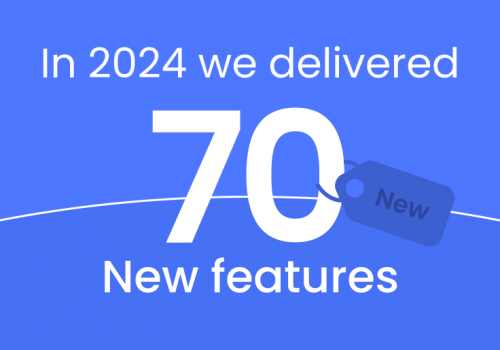Every business has to deal with unhappy customers. Even when you try your best to offer an excellent customer experience, the reality is, sometimes things go wrong. Sometimes customers have expectations that you are unaware of, and sometimes things happen that are outside of your control. Your goal shouldn’t be to have no unhappy customers but to turn your unhappy customers into loyal customers.
Consumers want to be assured that if they experience a problem, then it will be dealt with swiftly. This is why 96% of consumers say that customer service is an important factor in choosing which brands they are loyal to. Customers don’t expect you to make no mistakes, but they do expect you to solve them according to their expectations.
Falling short of these expectations can cost your business, both in terms of future purchases from that customer, and also in future business from potential customers that the customer relays their experience to. To avoid this happening to your business, let’s take a look at 7 ways you can turn unhappy customers into loyal customers.
7 Ways to Turn Unhappy Customers into Loyal Customers
Listen to Your Unhappy Customers
When we say, “listen to your customers”, we mean to make them feel heard. Let’s say a customer is angry because their order hasn’t arrived on time and they needed it for a time-sensitive event. The customer is frustrated when they call customer service and they already feel not listened to. They feel not listened to because they requested a delivery on a certain date, and for whatever reason, that request hasn’t been fulfilled.
Customer service agents can often be too quick to provide a solution to the customer, effectively cutting the customer off when they want to complain. This isn’t surprising. Customer service agents are often under immense time pressures that encourage them to look straight for a solution to the problem and move on to the next call. However, this can backfire.
The Customer isn’t just looking for a solution, they are looking for their problem to be acknowledged and validated, and they’re looking to see that your company has learned from the mistake. If you just offer a solution immediately, then the customer doesn’t get these key pieces of information that all help to ease their frustrations.
Make unhappy customers feel listened to by allowing them to vent their frustrations. You can also repeat back to them any frustrations they have and ask them to confirm you correctly understand. This has the effect of signaling to the customer that you’re paying attention and making note of their concerns.
Ask For Feedback
Only 6% of your unhappy customers will actually complain to your business. On the surface, this can look like a good thing – fewer angry calls are always a good thing, right? Not necessarily. Although only 6% of your customers will complain, 31% will share their bad experiences with other people, and 48% will avoid your brand in the future. Just because you aren’t receiving a high volume of angry calls doesn’t mean you don’t have a lot of angry customers. In fact, if your company has already established itself as anti-customer by garnering a poor customer service reputation then you may be getting even fewer calls because your unhappy customers think it’s futile to complain.
Complaints and unhappy customers are inherently negative for your business, but this doesn’t mean you have to resign yourself to defeat. You can use unhappy customers to evaluate what your company is doing well and what it isn’t. So, how do you get unhappy customers to talk?
Of course, you can’t force them to talk, but you can offer them the opportunity to. A great way to do this is with a customer feedback survey delivered to their email address. Not all unhappy customers will opt to complete the feedback, but many will. Customers want to feel listened to and this is one way that you can grant them the opportunity to be heard.
Helpful Tips for Customer Feedback Surveys
- Consider your questions carefully. Try not to ask leading questions to skew the results in your favor.
- Allow for open-ended questions so your customers have an opportunity to expand on their points. Sometimes our opinion can’t be captured in a multiple-choice question, so don’t force it.
- Allow a free-text field at the end where the customer can add comments not related to the questions. As much as we can try to create the perfect survey, you may have missed something. You may be assuming why your customers are unhappy when they are actually unhappy for a totally different reason that you didn’t consider. This box is their chance to highlight issues you may have missed.
- Don’t go overboard with questions. Surveys are only useful when they are completed, so don’t discourage customers from completing your survey by making it too long. Time is valuable, and no-one wants to spend an hour filling out a survey for a company they have negative feelings towards.

All of Your Platforms are Important
Nothing makes a customer angrier than feeling ignored. Some communication platforms feel more immediate and that means we often view them as more important. You can’t ignore a customer on a phone call or in Live Chat, you simply have to respond and respond quickly. However, with email or a contact form, it’s easier to justify putting your response lower on your priority list. “Well, they aren’t expecting a reply immediately, this can wait”. How long can you make a customer wait? According to Forrester, as of 2018, email was still the most commonly used digital customer service channel with 54% of customers having used it in the last year. Additionally, customers expect businesses to respond to emails within an hour.
Although email is old and less responsive than other forms of communication, it’s still extremely important. According to one study, if you want to satisfy 89% of your customers then you should respond to emails within one hour. If you want to provide world-class customer service, then you should respond within 15 minutes. Despite these statistics, few businesses prioritize speed when it comes to email. It’s common to fill out a complaint form and receive a do-not-reply email saying the company will be back to you in 5 working days (or something similar).
Your customers should experience the same level of service no matter what platform they choose. It’s become almost common knowledge that if you want a company to respond quickly, then you should Tweet them. This is because the tweet can be seen by lots of people, so companies are eager to control the damage before it spreads. This makes sense, but it can leave the customer with a bad impression of your company. It spends the message that you only ‘care’ when your reputation is at stake and not because you want to deliver a good customer experience.
Respond Quickly
This ties into our last point. Customers only continue to get angrier the longer they have to wait for a response. They already feel that you’ve let them down, and now they feel anxious that the problem will not be solved. A fast response can quell a lot of frustration and make the customer feel valued. Speed is everything to consumers in the digital age. 90% of consumers rated an “immediate” response as important or very important when they have a customer service question.
Making your customers wait is poor customer service and this can cost you future business. According to one study, 68% of consumers said they have stopped doing business with a brand due to a poor customer service experience.
In an ideal world, your customers would never be unhappy, and you wouldn’t need a customer service operation at all. This is unrealistic, problems do occur all the time for a multitude of reasons. It’s how your company responds to these problems that set you apart from your competition. You want to send the message to your customers that any time they experience an issue with your company, that you will listen and respond swiftly.
Don’t Shy Away From Public Discussions
If a customer sends you an angry Tweet, don’t try to rush the conversation into a private chat. Twitter is very public, and businesses often worry that a negative Tweet will gain traction and make their company look bad. This is why they try to take the conversation into Direct Messages as soon as possible. However, this isn’t always the best solution. Dealing with a complaint publicly is a great way to show potential customers how your company handles these situations. It’s marketing your customer service. If consumers can see a whole exchange between your company and the customer, where you can successfully turn an unhappy customer into a happy one, then you may just secure yourself new customers.

Be Sincere With Your Apologies
No one likes a hollow apology. For an example of an apology that wasn’t well-received by consumers, let’s look at a recent example from a well-known company. At BlizzCon 2018, gaming company Activision-Blizzard announced they would be re-releasing their beloved classic game, Warcraft 3. The release was expected to come sometime in 2019 and was described as a “re-imagining” of the original game. Blizzard showed excited onlooker’s teasers of the game including highly polished redone cutscenes cinematics that left fans eager for the game’s release.
The game launched in January 2020, and to say that fans were disappointed would be an understatement. Warcraft III: Reforged has a user score of 0.5/10 on Metacritic, making it one of the worst games on the site in terms of user rating. Fans were unhappy for several reasons. The promised cut scenes were non-existent, despite Blizzard still using them in their advertising. Blizzard also updated its terms to say that any content created by players would be completely owned by Blizzard, a move that players felt stifled their creativity. There are more reasons fans were unhappy, but the important thing to take away is that fans felt let down and were expecting an apology.
So, what was Blizzard’s apology? It started with: “First off, we want to say we’re sorry to those of you who didn’t have the experience you wanted, and we’d like to share our plans for what’s coming next,”.
This was very unsatisfactory for many fans and only furthered their anger. The apology lacks any responsibility on Blizzard’s part and almost shifts the blame to the customer. It suggests that it’s the customer’s expectations that were the problem, not that Blizzard made any mistakes.
For an apology to be sincere, it has to cost you something. This doesn’t necessarily mean money. Admitting you’re at fault risks costing your reputation, but it’s much more likely to win you favors with your customers. Take responsibility for issues that arise when your company is at fault.
Speak Like a Real Person
No one wants to feel angry. It makes us feel out of control. When you’re dealing with an angry customer, you’re dealing with someone who is feeling emotional and wants to be taken seriously. If you are too formal with your communication, you risk alienating the customer further.
You should be respectful but also informal. Address them by their first name, and don’t start using technical jargon or listing your corporate policies. It’s not helpful and you risk making the customer more frustrated.
It’s also important to vary your speech and be dynamic. Don’t just offer stock responses to questions because it makes the customer feel like you aren’t truly listening to them. It’s perfectly acceptable to give your customer service team general pointers or offer them some key phrases they can use. The problem comes when you create a script and demand that they stick to the script even when it’s proving to be unsuccessful. All people are different, and this means you can’t use the same approach for all of your customers.




















